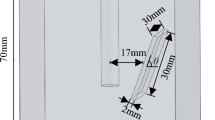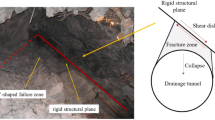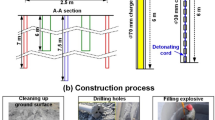Abstract
The evolution of the rocky reservoir bank is complex and difficult to predict because there is a lack of connection between changing mechanical states and reservoir water levels. Here, we propose an analytical method to study the evolution process of thick-layer dangerous rock masses (TDRM) on reservoir banks. This new method involves damage evolution and numerical simulation. Through this new method, the non-linear accelerated mechanical state of the TDRM can be continuously tracked, and the relationship between the changing water level and the progressive failure can be quantified. A dynamic collapse analysis can be carried out using parameters obtained from a predictive model. In this paper, the Jianchuandong dangerous rock mass (JDRM) located in the Three Gorges Reservoir area is selected as a case study to verify the new method. The predictive model was highly consistent with long-term monitoring and observational data. In addition, the failure process obtained by numerical simulation was identical to the typical dynamic characteristics of TDRM. Therefore, the effectiveness of this new method has been proven, and the method can be used to predict the evolution of TDRM on other reservoir banks.










Similar content being viewed by others
References
Cai MF, He MC, Liu DY (2006) Rock mechanics and engineering. China Science Press
Castelli F, Grasso S, Lentini V, Sammito MSV (2021) Effects of soil-foundation-interaction on the seismic response of a cooling tower by 3D-FEM analysis. Geosciences 11:200
Cen DF, Huang D, Ren F (2017) Shear deformation and strength of the interphase between the soil-rock mixture and the benched bedrock slope surface. Acta Geotech 12(2):391–413
Crosta GB, Imposimato S, Roddeman D (2016) Landslide spreading, impulse water waves and modelling of the Vajont rockslide. Rock Mech Rock Eng 49(6):2413–2436
Cundall PA (1971) A computer model for simulating progressive large scale movements in blocky rock systems. Proceedings of the Symposium of the International Society for Rock Mechanics, Society for Rock Mechanics (ISRM), France, II-8
Grasso S, Massimino MR, Sammito MSV (2021) New stress reduction factor for evaluating soil liquefaction in the coastal area of Catania (Italy). Geosciences 11:12
Grill G, Lehner B, Thieme M et al (2019) Mapping the world’s free-flowing rivers. Nature 569:215–221
He K, Chen CL, Li B (2019a) Case study of a rockfall in Chongqing, China: movement characteristics of the initial failure process of a tower-shaped rock mass. Bull Eng Geol Env 78(5):3295–3303
He K, Yin YP, Li B, Chen CL (2019b) The mechanism of the bottom-crashing rockfall of a massive layered carbonate rock mass at Zengziyan, Chongqing, China. J Earth Syst Sci 128(4):104
Huang BL, Zhang ZH, Yin YP, Ma F (2016) A case study of pillar-shaped rock mass failure in the Three Gorges Reservoir Area, China. Q J Eng Geol Hydrogeol 49:195–202
Huang BL, Yin YP, Tan JM (2019) Risk assessment for landslide-induced impulse waves in the Three Gorges Reservoir, China. Landslides 16(3):585–596
Huang BL, Yin YP, Yan GQ, Li B, Qin Z, Wang J (2021) A study on in situ measurements of carbonate rock mass degradation in the water-level fluctuation zone of the Three Gorges Reservoir, China. Bull Eng Geol Env 80(2):1091–1101
Hungr O, Leroueil S, Picarelli L (2014) The Varnes classification of landslide types, an update. Landslides 11(2):167–194
Jin WL, Zhao YX (2002) State-of-the-art on durability of concrete structures. J Zhejiang Univ (Eng Sci) 04:27–36+59. (in Chinese)
Kilburn CRJ, Petley DN (2003) Forecasting giant, catastrophic slope collapse: lessons from Vajont, Northern Italy. Geomorphology 54(1–2):21–32
Potyondy DO (2015) The bonded-particle model as a tool for rock mechanics research and application: current trends and future directions. Geosystem Eng 18(1):1–28
Rafiee R, Ataei M, KhalooKakaie R, Jalali SE, Sereshki F, Noroozi M (2018) Numerical modeling of influence parameters in cavabililty of rock mass in block caving mines. Int J Rock Mech Min Sci 105:22–27
Scaringi G, Fan XM, Xu Q, Liu C, Ouyang CJ, Domènech G, Yang F, Dai LX (2018) Some considerations on the use of numerical methods to simulate past landslides and possible new failures: the case of the recent Xinmo landslide (Sichuan, China). Landslides 15:1359–1375
Sun H, Gao YT, Elmo D, Jin AB, Wu SC, Dorador L (2019) A study of gravity flow based on the upside-down drop shape theory and considering rock shape and breakage. Rock Mech Rock Eng 52(3):881–893
Shen JY, Zhan SX, Karakus M, Zuo JP (2021) Effects of flaw width on cracking behavior of single-flawed rock specimens. Bull Eng Geol Env 80(2):1701–1711
Tang HM, Wasowski J, Juang CH (2019) Geohazards in the Three Gorges Reservoir Area, China – lessons learned from decades of research. Eng Geol 261:105267
Wang LQ, Yin YP, Zhang ZH, Huang BL, Wei YJ, Zhao P, Hu MJ (2019) Stability analysis of the Xinlu Village landslide (Chongqing, China) and the influence of rainfall. Landslides 16:1993–2004
Wang LQ, Yin YP, Huang BL, Dai ZW (2020a) Damage evolution and stability analysis of the Jianchuandong dangerous rock mass in the Three Gorges Reservoir Area. Eng Geol 265:105439
Wang LQ, Yin YP, Huang BL, Zhang ZH, Zhao P, Wei YJ (2020b) A study of the treatment of a dangerous thick submerged rock mass in the Three Gorges Reservoir Area. Bull Eng Geol Env 79(5):2579–2590
Wang LQ, Yin YP, Zhou CY, Huang BL, Wang WP (2020c) Damage evolution of hydraulically coupled Jianchuandong dangerous rock mass. Landslides 17(5):1083–1090
Wang LQ, Huang BL, Zhang ZH, Dai ZW, Zhao P, Hu MJ (2020d) The analysis of slippage failure of the HuangNanBei slope under dry-wet cycles in the Three Gorges Reservoir Region, China. Geomat Nat Haz Risk 11(1):1233–1249
Wang LQ, Zhang ZH, Huang BL, Hu MJ, Zhang CY (2021a) Triggering mechanism and possible evolution process of the ancient Qingshi landslide in the Three Gorges Reservoir. Geomat Nat Haz Risk 12(1):3160–3174
Wang LQ, Wu JH, Zhang WG, Wang L, Cui W (2021b) Efficient seismic stability analysis of embankment slopes subjected to water level changes using gradient boosting algorithms. Front Earth Sci 9:807317
Xiao T, Yu LB, Tian WM, Zhou C, Wang LQ (2021) Reducing local correlations among causal factor classifications as a strategy to improve landslide susceptibility mapping. Front Earth Sci 9:781674
Xing K, Zhou Z, Yang H, Liu BC (2020) Macro-meso freeze-thaw damage mechanism of soil-rock mixtures with different rock contents. Int J Pavement Eng 21(1):9–19
Yin YP, Huang BL, Wang WP, Wei YJ, Ma XH, Ma F, Zhao CJ (2016) Reservoir-induced landslides and risk control in Three Gorges Project on Yangtze River, China. J Rock Mech Geotech Eng 8(5):577–595
Zarfl C, Lumsdon AE, Berlekamp J, Tydecks L, Tockner K (2015) A global boom in hydropower dam construction. Aquat Sci 77(1):161–170
Funding
This study was supported by the National Key R&D Program of China (2019YFC1509605), the China Postdoctoral Science Foundation funded project (2021M700608) and Natural Science Foundation of Chongqing, China (cstc2021jcyj-bsh0047).
Author information
Authors and Affiliations
Corresponding author
Rights and permissions
About this article
Cite this article
Yin, Y., Wang, L., Zhang, W. et al. Research on the collapse process of a thick-layer dangerous rock on the reservoir bank. Bull Eng Geol Environ 81, 109 (2022). https://doi.org/10.1007/s10064-022-02618-x
Received:
Accepted:
Published:
DOI: https://doi.org/10.1007/s10064-022-02618-x




